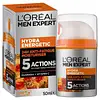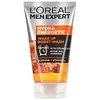What's inside
What's inside
 Key Ingredients
Key Ingredients

 Benefits
Benefits

 Concerns
Concerns

 Ingredients Side-by-side
Ingredients Side-by-side

Water
Skin ConditioningGlycerin
HumectantAlcohol Denat.
AntimicrobialIsohexadecane
EmollientHydrogenated Polyisobutene
EmollientAmmonium Polyacryloyldimethyl Taurate
Emulsion StabilisingMentha Piperita Extract
CleansingPEG/PPG-18/18 Dimethicone
EmulsifyingHdi/Trimethylol Hexyllactone Crosspolymer
Dimethicone
EmollientCetearyl Ethylhexanoate
EmollientCaffeine
Skin ConditioningSodium Citrate
BufferingSodium Hydroxide
BufferingSilica
AbrasiveLaminaria Digitata Extract
Skin ProtectingPaullinia Cupana Seed Extract
Skin ConditioningMagnesium PCA
HumectantAscorbyl Glucoside
AntioxidantIsopropyl Myristate
EmollientPropylene Glycol
HumectantCaprylyl Glycol
EmollientMenthol
MaskingPentylene Glycol
Skin ConditioningPolymethyl Methacrylate
Tocopherol
AntioxidantPhenoxyethanol
PreservativeCI 19140
Cosmetic ColorantCI 42090
Cosmetic ColorantLinalool
PerfumingLimonene
PerfumingParfum
MaskingWater, Glycerin, Alcohol Denat., Isohexadecane, Hydrogenated Polyisobutene, Ammonium Polyacryloyldimethyl Taurate, Mentha Piperita Extract, PEG/PPG-18/18 Dimethicone, Hdi/Trimethylol Hexyllactone Crosspolymer, Dimethicone, Cetearyl Ethylhexanoate, Caffeine, Sodium Citrate, Sodium Hydroxide, Silica, Laminaria Digitata Extract, Paullinia Cupana Seed Extract, Magnesium PCA, Ascorbyl Glucoside, Isopropyl Myristate, Propylene Glycol, Caprylyl Glycol, Menthol, Pentylene Glycol, Polymethyl Methacrylate, Tocopherol, Phenoxyethanol, CI 19140, CI 42090, Linalool, Limonene, Parfum
Water
Skin ConditioningSodium Laureth Sulfate
CleansingCoco-Betaine
CleansingGlycerin
HumectantSodium Chloride
MaskingMentha Piperita Extract
CleansingPPG-5-Ceteth-20
EmulsifyingSodium Hydroxide
BufferingPaullinia Cupana Seed Extract
Skin ConditioningAscorbyl Glucoside
AntioxidantPropylene Glycol
HumectantCitric Acid
BufferingMenthol
MaskingPentylene Glycol
Skin ConditioningPolyquaternium-7
Sodium Benzoate
MaskingSalicylic Acid
MaskingCI 16035
Cosmetic ColorantCI 19140
Cosmetic ColorantLinalool
PerfumingLimonene
PerfumingParfum
MaskingWater, Sodium Laureth Sulfate, Coco-Betaine, Glycerin, Sodium Chloride, Mentha Piperita Extract, PPG-5-Ceteth-20, Sodium Hydroxide, Paullinia Cupana Seed Extract, Ascorbyl Glucoside, Propylene Glycol, Citric Acid, Menthol, Pentylene Glycol, Polyquaternium-7, Sodium Benzoate, Salicylic Acid, CI 16035, CI 19140, Linalool, Limonene, Parfum
Ingredients Explained
These ingredients are found in both products.
Ingredients higher up in an ingredient list are typically present in a larger amount.
Ascorbyl Glucoside is a stable form of Vitamin C. It is created by combining glucose from starch.
When applied to skin, Ascorbyl Glucoside turns into Ascorbic Acid.
Ascorbyl Glucoside is an antioxidant. Antioxidants help fight free-radicals, or molecules that may damage skin cells.
It can help to reduce redness, improve skin texture, reduce the effects of aging, reduce the visibility of dark spots, and brighten skin.
Read more about other types of Vitamin C:
Learn more about Ascorbyl GlucosideCI 19140 is also known as Tartrazine. Tartrazine is a synthetic dye used in cosmetics, foods, and medicine to add a yellow color.
Tartrazine is created from petroleum and is water-soluble.
Some people may experience allergies from this dye, especially asthmatics and those with an aspirin intolerance.
Learn more about CI 19140Glycerin is already naturally found in your skin. It helps moisturize and protect your skin.
A study from 2016 found glycerin to be more effective as a humectant than AHAs and hyaluronic acid.
As a humectant, it helps the skin stay hydrated by pulling moisture to your skin. The low molecular weight of glycerin allows it to pull moisture into the deeper layers of your skin.
Hydrated skin improves your skin barrier; Your skin barrier helps protect against irritants and bacteria.
Glycerin has also been found to have antimicrobial and antiviral properties. Due to these properties, glycerin is often used in wound and burn treatments.
In cosmetics, glycerin is usually derived from plants such as soybean or palm. However, it can also be sourced from animals, such as tallow or animal fat.
This ingredient is organic, colorless, odorless, and non-toxic.
Glycerin is the name for this ingredient in American English. British English uses Glycerol/Glycerine.
Learn more about GlycerinLimonene is a fragrance that adds scent and taste to a formulation.
It's found in the peel oil of citrus fruits and other plants such as lavender and eucalyptus. The scent of limonene is generally described as "sweet citrus".
Limonene acts as an antioxidant, meaning it helps neutralize free radicals.
When exposed to air, oxidized limonene may sensitize the skin. Because of this, limonene is often avoided by people with sensitive skin.
The term 'fragrance' is not regulated in many countries. In many cases, it is up to the brand to define this term. For instance, many brands choose to label themselves as "fragrance-free" because they are not using synthetic fragrances. However, their products may still contain ingredients such as essential oils that are considered a fragrance.
Learn more about LimoneneLinalool is a fragrance and helps add scent to products. It's derived from common plants such as cinnamon, mint, citrus, and lavender.
Like Limonene, this ingredient oxidizes when exposed to air. Oxidized linalool can cause allergies and skin sensitivity.
This ingredient has a scent that is floral, spicy tropical, and citrus-like.
Learn more about LinaloolWe don't have a description for Mentha Piperita Extract yet.
Menthol is a compound found in mint plants, such as peppermint. In its pure form, it is a clear crystalline substance.
Menthol is known for its cooling sensation; however, the cooling is actually from your skin being sensitized. Menthol can worsen rosacea. We recommend speaking with a professional if you have concerns.
Menthol also has antimicrobial properties.
Learn more about MentholParfum is a catch-all term for an ingredient or more that is used to give a scent to products.
Also called "fragrance", this ingredient can be a blend of hundreds of chemicals or plant oils. This means every product with "fragrance" or "parfum" in the ingredients list is a different mixture.
For instance, Habanolide is a proprietary trade name for a specific aroma chemical. When used as a fragrance ingredient in cosmetics, most aroma chemicals fall under the broad labeling category of “FRAGRANCE” or “PARFUM” according to EU and US regulations.
The term 'parfum' or 'fragrance' is not regulated in many countries. In many cases, it is up to the brand to define this term.
For instance, many brands choose to label themselves as "fragrance-free" because they are not using synthetic fragrances. However, their products may still contain ingredients such as essential oils that are considered a fragrance by INCI standards.
One example is Calendula flower extract. Calendula is an essential oil that still imparts a scent or 'fragrance'.
Depending on the blend, the ingredients in the mixture can cause allergies and sensitivities on the skin. Some ingredients that are known EU allergens include linalool and citronellol.
Parfum can also be used to mask or cover an unpleasant scent.
The bottom line is: not all fragrances/parfum/ingredients are created equally. If you are worried about fragrances, we recommend taking a closer look at an ingredient. And of course, we always recommend speaking with a professional.
Learn more about ParfumWe don't have a description for Paullinia Cupana Seed Extract yet.
Pentylene glycol is typically used within a product to thicken it. It also adds a smooth, soft, and moisturizing feel to the product. It is naturally found in plants such as sugar beets.
The hydrophilic trait of Pentylene Glycol makes it a humectant. As a humectant, Pentylene Glycol helps draw moisture from the air to your skin. This can help keep your skin hydrated.
This property also makes Pentylene Glycol a great texture enhancer. It can also help thicken or stabilize a product.
Pentylene Glycol also acts as a mild preservative and helps to keep a product microbe-free.
Some people may experience mild eye and skin irritation from Pentylene Glycol. We always recommend speaking with a professional about using this ingredient in your routine.
Pentylene Glycol has a low molecular weight and is part of the 1,2-glycol family.
Learn more about Pentylene GlycolPropylene Glycol is an odorless, colorless liquid. As a humectant, it helps skin retain moisture. It also aids in delivering active ingredients.
Another role of this ingredient is preventing a product from melting or freezing. Propylene glycol also adds antimicrobrial properties to a product, elongating product lifespan.
This ingredient is considered an organic alcohol and commonly added into both cosmetics and foods.
Those with sensitive skin or conditions may develop a rash when using this ingredient.
Learn more about Propylene GlycolSodium Hydroxide is also known as lye or caustic soda. It is used to adjust the pH of products; many ingredients require a specific pH to be effective.
In small amounts, sodium hydroxide is considered safe to use. However, large amounts may cause chemical burns due to its high alkaline.
Your skin has a natural pH and acid mantle. This acid mantle helps prevent harmful bacteria from breaking through. The acid mantle also helps keep your skin hydrated.
"Alkaline" refers to a high pH level. A low pH level would be considered acidic.
Learn more about Sodium HydroxideWater. It's the most common cosmetic ingredient of all. You'll usually see it at the top of ingredient lists, meaning that it makes up the largest part of the product.
So why is it so popular? Water most often acts as a solvent - this means that it helps dissolve other ingredients into the formulation.
You'll also recognize water as that liquid we all need to stay alive. If you see this, drink a glass of water. Stay hydrated!
Learn more about Water